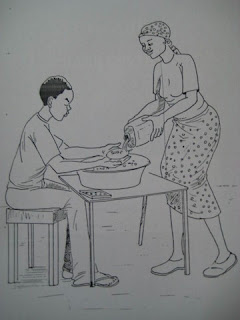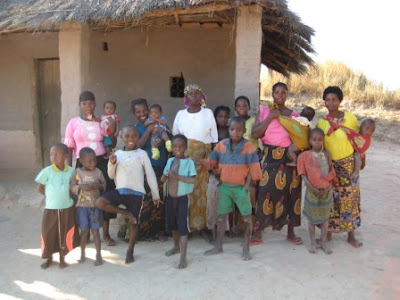Wednesday, July 30, 2008
Books I have read this summer
The Hitchhiker's Guide to the Galaxy (Douglas Adams)
The Restaurant at the end of the Universe (Douglas Adams)
Life of Pi (Yann Mortel)
Tao of Coaching (Max Landsberg)
Critical Villager (Eric Dudley)
Mountains Beyond Mountains (Tracy Kidder)
Blink (Malcolm Gladwell)
Monday, July 28, 2008
Open Defecation (a.k.a. “Shitting in the Bush”) and Other Risky Behaviours
Risky Behaviour #1: Open Defecation (a.k.a. “shitting in the bush”)

Risky Behviour #2: Not washing your hands
There are a variety of risky hand washing habits. The most basic risky behaviour is not washing your hands at all. Why is it risky? Toilet paper isn't used so much in the village, so it's either a leaf or your left hand! Way forward: build and use a hand washing station outside your latrine.
 Risky Behaviour #3: Leaving dishes on the ground
Risky Behaviour #3: Leaving dishes on the ground
 Most cooking is done outside and dishes, even after they are washed, are left on the ground. There's no kitchen, let alone a sink or counter top. So animal like chickens, goats, dogs, and pigs can sniff, lick, and step in dishes, pots, and pans! Why is it risky? All of these animals are also free to roam in the bush (see Risky Behaviour #1). Way forward: build a dish rack to dry & store your dishes.
Most cooking is done outside and dishes, even after they are washed, are left on the ground. There's no kitchen, let alone a sink or counter top. So animal like chickens, goats, dogs, and pigs can sniff, lick, and step in dishes, pots, and pans! Why is it risky? All of these animals are also free to roam in the bush (see Risky Behaviour #1). Way forward: build a dish rack to dry & store your dishes.
Risky Behaviour #4: Washing hands in shared water

...etc.
So what do you think about this? It may seem like common sense to wash your hands after going to the bathroom in the west. Why do you wash your hands after going to the bathroom? Why do you bother using the bathroom?
*Drawings are from a PHAST training guide*
Friday, July 25, 2008
A Typical Day in Milenge District
I return to the Mumba's house and find the mother sweeping,
We wait for maybe 30 minutes for the villagers to gather. Time is very relaxed! Throughout the meeting, the hygiene promoters discuss "Risky Behaviors" such as not washing your hands before eating. I am learning Bemba and understand some of it brokenly and the hygiene promoters also translate for me.
Tuesday, July 22, 2008
What am I eating?

Chicken
Fish, lots and lots of fish
Goat
Hippo
Game meat

Sweet potatoes
Sweet potatoe leaves
Cassava tubers
Cassava leaves

Pumpkin leaves
Pumpkin
Cabbage
Soya pieces (really good!)
Tomatoes
Beans
Popo
Peanut butter (home-made!)
Bread
Oatmeal
Sweet bread (made in a pot)
Fritters
Rice
Boiled sorghum
Popcorn, shortbread cookies
Oranges, watermelon, apples, bananas


Water, orange juice, fanta, coke, sprite, carbonated apple juice, tea, honey

Friday, July 18, 2008
From the Black Proboscis to Zambian Bicycles
Here is a short dialogue I had on my first day of work at the health clinic in Milenge:
Doctor: “You have Malaria.”
Me: “Haha, okay where do I go to get the treatment?”
So starting work in Milenge was delayed about a week and a half for me because I got Malaria. I am trying to avoid the black proboscis (aka the mosquito) with a mosquito net at night, mosquito repellent, and covering as much skin as possible! I guess the mosquitoes in Milenge are really sneaky!
In Milenge, I am living with a woman named Charity who is a secretary at the Ministry of Education office. Charity’s niece and cousin (Cathrine and Penlope) also live in the house. Cathrine is 17 and Penlope is about 15. They both go to school in Milenge. They were awesome help when I was sick and, when I was healthy, introduced me to a lot of Zambian culture! For example, they taught me how to cook nshima – the staple food in Zambia – and I made my first pot of nshima on June 22! They said it tasted great. Until that point my arms weren’t strong enough to stir the nshima until it was done, so the girls would always finish preparing it.
Penlope
The chicken that sometimes sleeps in my room
Her eggs, which are taking a long time to hatch!
I have actually only lived with Charity and the girls for about two weeks because I’ve been traveling around Milenge. For one week I lived in Kapalala ward with Mr. Anthony Mumba, a hygiene promoter, and his family. Another week I stayed with Ms. Hennedy Mwewa Perfecta and her family in Mumbotuta ward. I have been living in the wards to learn as much as possible about the projects in my first month here. The project officer for the Milenge WaterAid project has not been so there wouldn’t be much to do alone in the office.
Hennedy (top left) and her family
Hennedy and her son, Steward, at Mumbotuta falls
Me, grinding sorghum. Hennedy makes nshima from sorghum flour.
I received my bicycle before leaving for Hennedy’s home. But I had some bike problems in Mumbotuta. My front tire punctured the first day with Hennedy. After a group of village men tried to repair it, justified that I was “so very fat”, and the tire punctured again, everyone agreed I needed a new tire. (Here it’s a compliment to be called fat) The next day my other tire punctured but we replaced it immediately.
I am on my way to the middle-of-term retreat with the other JFs. I will return to Milenge, the land without internet or chocolate, on July 12!
Tuesday, July 15, 2008
WaterAid in Milenge (cnt'd)
When a location is selected for a well, the villagers around that site are responsible for digging he well and collecting sand and stones for the well structure. Sand and stones are available locally. The water technicians use the sand, stones, and concrete (provided b he MDC and WaterAid) to cast rings that line the hand dug well. Once the rings are lowered into the well, it is capped with a concrete slab. This is a reliable source of clean water year round for the village. To complete a well, the water technicians will also install a pump (if there is no pump, villagers lower a bucket by rope to fetch water) and cast a concrete ˝apron˝. The purpose of the apron is similar to when a baby wears an apron: it helps maintain the cleanliness around the mouth of the well b carrying water down a slope away from the mouth of the well.
Water technician starting to measure out sand. Next he will add stones, concrete, and then water.
The concrete is then poored into the ring mold. This will be left for one day and then the mold can be popped off.This is a well that was dug and is waiting for concrete lining. The well is eight metres deep and requires 17 concrete rings!
Part 2: Sanitation Platforms
When a household is selected to receive a lartrine, the household is responsible for digging he pit for the latrine and gathering bricks, sand, and stones. For a household larine, he sanitation technicians use mud and bricks to build a sort of pyramid above the pit. Then, the technicians cast a sanitation platform (sanplat) that is placed above the pyramid. The household is then responsible for building a superstructure around the sanplat for privacy. (We also build latrines for schools, but I haven't learned too much about that yet)
Sanitation technician leveling the ground around the pit for this latrine
Sanitation technicians building a "pyramid" of bricks and will place the sanplat on top
Sanplat
Finished latrine (household built superstructure around sanplat)
Villagers make their own bricks
Part 3: Hygiene Promotion
The hygiene promoters in the wards have variety of responsibilities. They hold meetings in villages (with men, women, and children) and in schools to discuss hygiene issues in that village and promote hygienic behaviours (ie. Washing hands with soap) They also meet with village headmen, church committees, and school managers so that all of the community leaders/groups know about the WaterAid program and can help promote them. Hygiene promoters also report to Eddy, the program officer, on the progress of building wells and latrines and monitor the quality of these facilities.
Saturday, July 12, 2008
WaterAid in Milenge
WaterAid is an international non-governmental organization based out of the
In Milenge district, where I`m working, WaterAid works with the local government, the Milenge District Council (MDC). Mr. Eddy Chitalu is the Program Officer (an employee of the MDC) and is in charge of the WaterAid project. Milenge ditrict is divided into wards. We work in four wards: Mikula, Kapalala, Sokontwe, and Mumbotuta. In each ward there are hygiene promoters, water technicians, and sanitation technicians. Each are local members of their communities:
What do we do in Milenge?
Overall, we are working to provide safe drinking water, sanitation, and hygiene education…tune into my next post for more info on all three!!
Here is a pic of the Luapula River, which is just next to my office in Milenge!




















